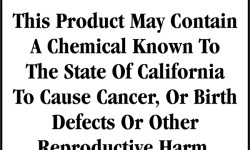Chemical Reform for Your Valentine

In honor of Valentine’s day, we’re re-posting our op-ed from last year about Valentine’s Day chocolates and Proposition 65.
Chemical reform for your Valentine
By Joseph Perrone, Sc.D.
Valentine’s Day can be a stressful holiday. Have you picked out the perfect gift? The right dinner reservation? And that’s just if you’re part of a couple—for everyone else, there’s the stress of the constant barrage of jewelry and flower ads reminding you of your single status.
Now, environmental activists want to add one more stress to your holiday: worrying whether you’re gifting your sweetheart (or yourself) valentine chocolates laced with lead and cadmium.
California environmentalists are stoking fears across the country with their lawsuit claiming major candy makers are violating the state’s chemical warning law, known as Proposition 65. The law requires manufacturers and retailers to include a warning label if a product contains one of over 800 chemicals that California regulators have identified as possible causes of cancer or reproductive harm.
Naturally, no one wants to eat chocolate or any product that contains dangerous chemicals. But products that display a Proposition 65-mandated warning label aren’t necessarily hazardous to your health.
That’s because California’s law doesn’t give consumers any context to tell them how much risk a product poses. The threshold for determining whether a chemical poses a health risk is incredibly low: A chemical earns a place on the state’s list of dangerous chemicals if California regulators find that exposure causes one excess case of cancer in 100,000 individuals over a 70 year period.
In the case of your Valentine’s Day candy? The environmentalists in this lawsuit claim that 26 products they tested had higher levels of lead and cadmium than allowed under Proposition 65. But that shouldn’t send you scrambling to throw out perfectly good chocolate.
You may not realize it, but heavy metals are in a lot of food products. As the U.S. Food and Drug Administration (FDA) states, “Because lead may be present in environments where food crops are grown and animals used for food are raised, various foods may contain unavoidable but small amounts of lead that do not pose a significant risk to human health.”
The California environmentalists didn’t say how much lead or cadmium they found in the dark chocolate samples, but looking at other research of heavy metal levels in chocolate, you’d have to eat copious amounts of chocolate to even begin to worry about your lead or cadmium exposure.
Last year, a study in the Journal of Agricultural and Food Chemistry examined the levels of lead and cadmium in white, milk, and dark chocolate sold in Brazil. They concluded that dark chocolates had the highest amounts of lead and cadmium, but all levels fell below maximum consumption limits from Brazil, the European Union, and the World Health Organization (WHO) and most fell below the U.S. FDA’s limits. The researchers also pointed out that only a tiny fraction of the lead or cadmium present in chocolate would actually absorb into an individual’s bloodstream.
Number crunching by Confectionary News (and confirmed by the study’s authors) revealed that in order to exceed the WHO’s guidance for monthly cadmium exposure, a child would have to eat 174 regular sized dark chocolate bars or 789 regular sized milk chocolate bars.
That’s way more chocolate than children (or adults) actually eat.
California’s Proposition 65 has needlessly scared consumers much more than it’s actually improved public health and safety. This latest headline-seeking chocolate lawsuit is just another reason why it’s time for Congress to finally update our 1970s national chemical safety law and get rid of California’s ability to scare the entire country about the safety of millions of every day products.
Dark chocolate was first considered an aphrodisiac by the Aztecs. Let’s not let California environmentalists kill the mood this Valentine’s Day.





